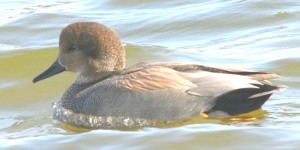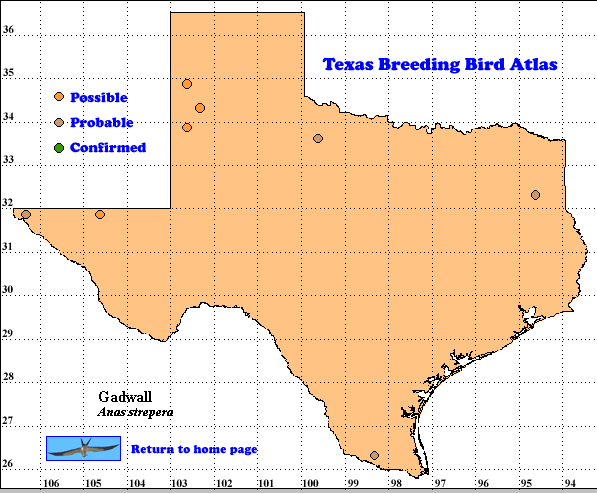Gadwall are medium-sized dabbling ducks with higher rates of reproductive success than other North American dabbling ducks. This characteristic enables them to better survive and recover from adverse conditions, such as the severe drought of the 1960s, 1970s and early 1980s. The impressive reproductive success is achieved despite the departure of the male during incubation (Leschack et al. 1997).
DISTRIBUTION. During the 1987-1992 field work seasons of the TBBA project, volunteers found 4 probable and 5 possible nesting sites for Gadwall. Of these 4 possibles were in the western Panhandle and one probables and one possible were in the Trans-Pecos region (see the region map in Lockwood and Freeman [2004]). These authors consider Gadwall a rare and somewhat local summer resident, especially in the Panhandle, with a few nesting records. The map in Oberholser (1974) shows a small number of summer records, mostly in the Panhandle and one breeding site there. In Oklahoma atlasers found 3 probable breeding sites in their panhandle (Grzybowski 2004).
In this hemisphere Gadwall breed primarily on the prairies of western Canada and the Dakotas and in major wetland areas of the western United States. Other populations breed widely in Europe and Asia. The North American population winters in the southern United States and coastal Mexico (Howell and Webb 1995, Leschack et al. 1997, Am. Ornithol.Union 1998, Sauer et al. 2008).
SEASONAL OCCURRENCE. Gadwall are common to abundant migrants and winter residents in Texas which has some of the highest wintering concentrations in North America along the coast. These ducks begin arriving in this state as early as late August with most coming in October. They are present until late May. The breeding season apparently starts well before the last migrant has left since in Colorado fledged young were observed by atlasers from May 29 to August 5 (Oberholser 1974, Leschack et al. 1997, Boyle 1998, Lockwood and Freeman 2004).
BREEDING HABITAT. In Colorado atlasers found young Gadwall almost exclusively on lakes, swamps and wetlands with or without emergent or floating vegetation (Boyle 1998). In Arizona almost all young of this species were found on wetlands edged with emergent vegetation (Piest 2005). In or near these habitats, Gadwall nests are usually placed in tall, dense vegetation in prairies, fields and meadows. The nest is built by the female in a shallow bowl, scrapped in soil. The nest contains rushes, grasses and roots. gathered at the site and is lined with bits of vegetation and down feathers (Harrison 1979, Leschack et al. 1997).
In the nest the female usually lays 10-12 (range 6-13) smooth, dull, creamy white to grayish green, unmarked eggs, one per day They are indistinguishable from those of American Wigeon (Anas americana). The nests can be distinguished by the larger size and darker color of the down feathers in Gadwall nests. Most males leave to molt after the clutch is complete. The eggs are incubated by the female for 24-27 days. Nest success is very variable, but often high. After hatching the female leads the precocial young, capable of feeding themselves, to open water, usually surrounded by dense vegetation. Here she broods them at night for up to 14 days. The young are capable of flight about 50 days after hatching and have been abandoned by the female before then (Harrison 1979, Leschack et al. 1997).
STATUS. The North American Breeding Bird Survey does mot sample this rare breeder in Texas, but data from 435 routes across North America provide a statistically significant annual population change of +3.8% for the period 1980-2007 (Sauer et al. 2008). This trend and the large size of the wintering population of Gadwall in Texas suggest this species will be a part of the Texas avifauna for years.
Text by Robert C. Tweit (2008)
Literature cited.
American Ornithologists’ Union. 1998. Checklist of North American birds, 7th ed. Am, Ornithol. Union, Washington, DC.
Boyle, S.. 1998. Gadwall (Anas strepera). In Colorado breeding bird atlas, pp. 72-73 (H. E. Kingery, ed.), Colorado Bird Atlas Partnership, Denver.
Grzybowski, J. A. 2004. Gadwall (Anas strepera). In Oklahoma breeding bird atlas, pp. 66-67 (D. L. Reinking, ed.). University of Oklahoma Press, Norman.
Harrison, H. H. 1979. A field guide to western birds’ nests. Houghton Mifflin, Boston, MA.
Howell, S. N. G. and S. Webb. 1995. A guide to the birds of Mexico and northern Central America. Oxford University Press, New York.
Leschack, C. R., S. K. McKnight and G. R. Hepp. 1997. Gadwall (Anas strepera), The Birds of North America Online (A. Poole, Ed.). Ithaca: Cornell Lab of Ornithology; Retrieved from: http://bna.birds.cornell.edu/bna/species/283
Lockwood, M. W. and B. Freeman. 2004. The TOS handbook of Texas birds. Texas A&M University Press, College Station.
Oberholser, H. C. 1974. The bird life of Texas. University of Texas Press, Austin.
Piest, L. 2005. Gadwall (Anas strepera). In Arizona breeding bird atlas. pp. 56-57 (T. E. Corman and C. Wise-Gervais, eds.), University of New Mexico Press, Albuquerque.
Sauer, J. R., J. E. Hines, and J. Fallon. 2008. The North American breeding bird survey, results and analysis 1966-2007. Version 5.15. 2008. USGS Patuxent Wildlife Research Center, Laurel MD < http://www.mbr-pwrc.usgs.gov/bbs>

